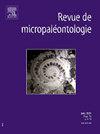A reassessment of the type-materials of Ostracoda (Crustacea, Oligostraca) lost in the “Museu Nacional” Great Fire of September 2, 2018
IF 1
Q4 PALEONTOLOGY
引用次数: 0
Abstract
On September 2, 2018, a catastrophic fire occurred at the “Museu Nacional” in Rio de Janeiro, Brazil, nearly destroying its once rich scientific collections. That accident latter generated a movement from the museum and the scientific community to restore their collections, either by bringing new specimens to the institution or by providing information about the ones lost in the tragedy. Herein we present our contribution to that effort: high-resolution scanning electron microscope images of holotypes and paratypes of 23 fossil ostracod species and subspecies that were destroyed by the “Museu Nacional” fire. These taxa occur in several Brazilian and central West African Lower Cretaceous lithological units, and some of them (Cypridea [Pseudocypridina] faveolata and Sebastianites fida minor) are even guide fossils to these strata. The present images and taxonomical updates of species – including new combinations for Sebastianites fida minor, Sebastianites? minima, Sebastianites? sostensis granulata and Theriosynoecum ventrostriatum – will also enable future studies of ostracod species from Brazilian and central West African Lower Cretaceous basins, as they provide an accurate system of identification in absence of direct observation of these type specimens once housed at the “Museu Nacional” scientific collections.
2018年9月2日“国家博物馆”大火中损失的介形虫类(甲壳纲,寡介形虫科)的类型材料重新评估
2018年9月2日,巴西里约热内卢“国家博物馆”发生灾难性火灾,几乎摧毁了其曾经丰富的科学收藏品。后来,那次事故引发了博物馆和科学界的一场运动,他们要么给博物馆带来新的标本,要么提供在这场悲剧中失去的标本的信息,以恢复他们的藏品。在此,我们展示了我们对这一努力的贡献:在“国家博物馆”大火中被烧毁的23种化石介形虫物种和亚种的全型和准型的高分辨率扫描电镜图像。这些分类群出现在巴西和西非中部的几个下白垩世岩性单元中,其中一些(Cypridea [pseudoypridina] faveolata和Sebastianites fida minor)甚至是这些地层的指导化石。目前的图像和物种的分类更新-包括新组合的Sebastianites fida minor, Sebastianites?最小值,黑云钙长岩?这也将使未来对来自巴西和西非中部下白垩纪盆地的介形虫物种的研究成为可能,因为它们提供了一个准确的识别系统,而这些类型标本曾经被存放在“国家博物馆”的科学收藏中,没有直接观察。
本文章由计算机程序翻译,如有差异,请以英文原文为准。
求助全文
约1分钟内获得全文
求助全文
来源期刊

REVUE DE MICROPALEONTOLOGIE
PALEONTOLOGY-
CiteScore
2.50
自引率
0.00%
发文量
17
期刊介绍:
La Revue de micropaléontologie publie 4 fois par an des articles de intérêt international, consacrés à tous les aspects de la micropaléontologie. Les textes, en anglais ou en français, sont des articles originaux, des résultats de recherche, des synthèses et mises au point, des comptes rendus de réunions scientifiques et des analyses de ouvrages. La revue se veut résolument ouverte à tous les aspects de la micropaléontologie en accueillant des travaux traitant de la systématique des microfossiles (et de leurs équivalents actuels), des bactéries aux microrestes de vertébrés, et de toutes leurs applications en sciences biologiques et géologiques.
 求助内容:
求助内容: 应助结果提醒方式:
应助结果提醒方式:


